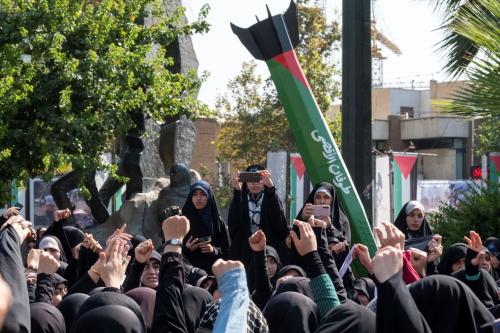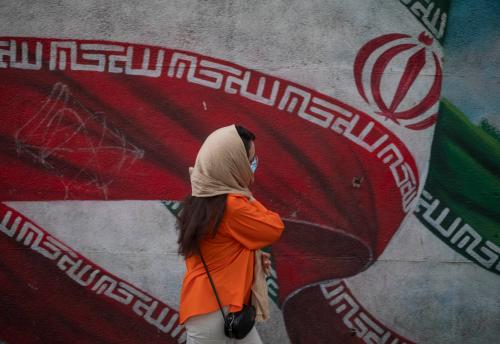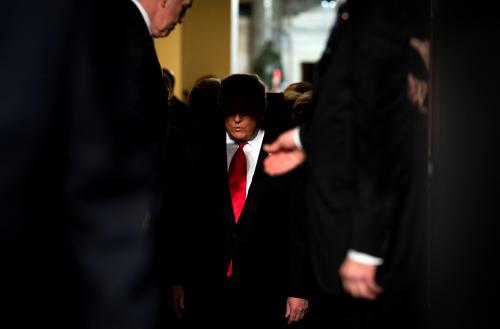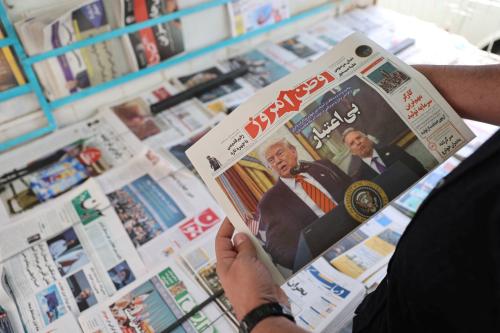The following testimony was submitted to the Senate Committee on Foreign Relations on February 28, 2024, for the “Tehran’s Shadow Army: Addressing Iran’s Proxy Network in the Middle East” hearing.
Chairman Cardin, Ranking Member Risch, and distinguished members, thank you for inviting me to contribute my views on the intensifying threats posed by Iran’s proxy network across the Middle East and how U.S. policy might counter these threats most effectively. It is an honor for me to address this committee.
I am vice president and director of Foreign Policy at the Brookings Institution, a U.S. nonprofit organization devoted to independent research and policy solutions. Brookings’ mission is to conduct high-quality, independent research and provide innovative, practical recommendations based on that research for policymakers and the public. My testimony represents solely my personal views and does not reflect the views of Brookings, its other scholars, employees, officers, and/or trustees.
The Islamic Republic of Iran presents a serious and abiding threat to U.S. national security through its decades-long bid to achieve a nuclear weapons capability; its extensive track record of terrorism, hostage-taking, and violent subversion; its deepening involvement in Russia’s barbaric and illegal war in Ukraine; and its brutality toward its own citizens. One of the most valuable tools in the Iranian arsenal is the network of militias that its leadership has cultivated, coordinated, trained, and supplied with advanced weaponry. The network extends across the broader Middle East from Lebanon to Pakistan, and these proxies have proven integral to Tehran’s security, longevity, and influence. They provide the Islamic Republic with strategic depth and wide regional influence and access while insulating Iran’s leadership from the full risk of their actions.
Since the shocking massacres perpetrated by Hamas in Israel on October 7, hostile actions by Iran’s proxy militias have dramatically escalated in ways that pose a complex challenge for Washington and the world. Already, militia attacks have resulted in at least 186 injuries or deaths to American troops serving in the Middle East, including 130 who have suffered traumatic brain injuries and the tragic loss of three U.S. service members in Jordan, as well as two U.S. Navy SEALs killed in a mission to interdict illicit Iranian weapons.1 And the Iran-backed Houthi movement in Yemen has launched at least 57 attacks on commercial shipping in the Red Sea, prompting the rerouting of maritime freight traffic with significant delays and additional cost.
The persistence of deadly militia violence augurs even greater risks. A miscalculation by any of the actors involved could ignite a much wider and more intense conflict across the Middle East, with profound damage to regional stability and the global economy. Over the long term, the empowerment of these nonstate armed actors contributes to the erosion of governance and security across the region to the advantage of Iran and other bad actors.
Over the past four and a half months, the Biden administration has been resolute and pragmatic in managing the threats posed by Tehran and its self-described “axis of resistance” in the wake of Israel’s war in Gaza. The rapid deployment of American military assets to the region, together with tireless diplomatic engagement by President Joe Biden and a host of senior U.S. officials, have thus far succeeded in averting the wider war that Hamas had hoped to precipitate. And a series of U.S. retaliatory strikes in Iraq, Syria, and Yemen since October have degraded militia capabilities and leadership and signaled to Tehran’s partners that they will pay a steep price for continued aggression against Americans. Still, the post-October 7 strategic landscape demands more from both the United States and its allies and partners in the Middle East and beyond.
Iran’s proxy network in the Middle East
One of the most important elements of Iran’s regional and international power projection is its deployment of proxy militias. Over decades, and with only limited effective pushback from regional states or the international community, Tehran has assembled an adaptive, layered network of regional militias with discrete organizational structures and leadership and overlapping interests and ties to Iran’s security and religious establishments. This proxy infrastructure has enabled the Islamic Republic to wield significant sway and sow instability across the broader Middle East and beyond while preserving plausible deniability. Although these relationships are often highly opportunistic, that does not invalidate their utility for either side of the equation; in many respects, it reflects shared preferences for autonomy and self-interest. And the evolutionary nature of Iranian investments in its clients has worked to its advantage, enabling Iran’s security establishment to build partnerships of enduring strategic value.
Over four decades, militant proxy groups have become a core component of the Islamic Republic’s regional and international strategy, which relies on asymmetric warfare to gain leverage against more powerful adversaries, including and especially the United States. In seeking to entrench its own influence at the expense of its adversaries, Iran’s power projection via proxies is purposeful rather than wanton, conscious of the balance of costs and benefits, determined to exploit openings or weaknesses, inventive in its implementation, and wide-ranging in scope. Iran’s access has been boosted by the elimination of its historic competitors among the radical camp in the Middle East. As deep-pocketed dictators like Saddam Hussein and Moammar Gaddafi were eliminated from the scene, the Islamic Republic has become one of the only games in town.
Tehran’s operational governance of its proxies has proven versatile and dynamic, utilizing umbrella groups and joint operation rooms to coalesce and direct diverse factions, while at other times fragmenting existing groups as a means of maintaining its sway.2 While Iran’s provision of funding and materiel support has long been a central dimension of sustaining its relationships with individual militias, increasingly, Tehran is equipped to transfer not just weaponry but the means of production and modification to enable independent manufacturing as well. Any risks of obsolescence seem to be outweighed by the opportunity to build redundancy of supply, seed innovation, and enhance deniability.3
A brief review of Iran’s “shadow army” will focus on its most prominent and effective components—Hezbollah in Lebanon, Palestinian Islamic Jihad and Hamas, the panoply of Iraqi Shia militias, and the Houthis in Yemen. These groups have emerged as the most powerful nodes of Iran’s militia network, but they represent only a small minority of the multitude of groups across the world that Tehran has patronized over the past 45 years.
Iran’s proxy network emerged organically from the transnational operational and ideational networks that facilitated the 1979 revolution. From the inception of the Islamic Republic, its leadership has harbored expansive ambitions. The ideology that shaped Iran’s post-revolutionary state was explicitly universalist, and its first leader, Ayatollah Ruhollah Khomeini, maintained that exporting the revolution was necessary for its survival, arguing that “[i]f we remain in an enclosed environment we shall definitely face defeat.”4 Determined to spark a wider wave of upheavals, its leaders developed an infrastructure dedicated to toppling the status quo across the Muslim world through proxy groups, Islamist propaganda, and the instrumental use of extraterritorial violence. To extend the regime’s vision of an Islamic order, Tehran sought to subvert its neighbors through attempted coups, assassinations, and bombings.
Despite wide-ranging efforts, the anticipated revolutionary wave failed to materialize. Still, the Islamic Republic’s early investments yielded one enduring asset: the Lebanese Shia militia Hezbollah. Iran’s Islamic Revolutionary Guard Corps (IRGC) played a foundational role in forging the organization after the 1982 Israeli invasion of Lebanon, building on communal and clerical ties between the two states, as well as collaboration among militants during the 1970s. Hezbollah’s long and bloody track record includes a devastating series of suicide bombings in 1983 and 1984 that targeted U.S. and French government facilities in Lebanon, as well as kidnappings, hijackings, and actions further afield, such as the 1994 bombing of a Jewish cultural center in Argentina and the 2012 suicide bombing that killed five Israeli tourists in Bulgaria. Hezbollah has fought and survived multiple wars with Israel, maintains tens of thousands of active fighters, and with Tehran’s help has amassed a massive arsenal estimated to include 150,000 rockets and missiles, mostly short-range and unguided, as well as drones, precision missiles, anti-tank, anti-aircraft, and anti-ship missiles.5
Through its political wing, Hezbollah has insinuated itself firmly in the fraught Lebanese government, with members serving in parliament and in the cabinet. This political role has not tempered the group’s reliance on coercion; several Hezbollah members have been convicted in the 2005 assassination of former Lebanese Prime Minister Rafiq Hariri.
Today, Hezbollah is the jewel in the crown of the Iranian proxy network; as Maj. Gen. Aharon Haliva, who heads Israeli military intelligence, has noted, “For a while now Hezbollah has not been a proxy of Iran; it is an inseparable part of the decision making process in Tehran … It is no longer a discussion of whether Hezbollah is the defender of Lebanon, the defender of the Shiites, or the defender of Iran and just one part of the axis. It is the axis [emphasis added].”6 Its ideological affinity with Tehran is unique, its commitment to “resistance” unyielding, and it proved central to the Islamic Republic’s existential struggle to sustain Bashar Assad’s regime after the eruption of the Syrian civil war. That conflict elevated Hezbollah to first among equals, working closely with the IRGC to provide training and coordination among a wider transnational network of Shiite militias from Iraq, Afghanistan, Pakistan, and Yemen.
Tehran’s deep involvement in Lebanon also provided the springboard for its patronage of various Palestinian groups, which also built on extensive pre-revolutionary interactions. The Palestinian issue has always loomed large for the Islamic Republic’s leadership, but historically, their inroads with Palestinian groups have been limited by sectarian and doctrinal differences, as well as by Yasser Arafat’s embrace of Tehran’s mortal enemy, Iraqi leader Saddam Hussein. One key exception to that estrangement was Palestinian Islamic Jihad (PIJ), a small Sunni group that fused Muslim Brotherhood doctrine with an affinity for the Iranian revolution. Embraced by the IRGC, PIJ’s commitment to militancy made it a valuable partner for Tehran in its efforts to sabotage U.S.-led efforts to advance peace between Israelis and Palestinians.
In its outreach to the Palestinians, Tehran has consistently sought to court Hamas, which emerged in the 1980s as the most influential opponent of Palestinian-Israeli peacemaking. With strong roots in the Muslim Brotherhood movement, Hamas leaders traditionally kept Tehran at a greater distance than PIJ, although they too were receptive to Iranian funding and arms supplies. But the relationship shifted in the mid-2000s, with the assassination of the group’s founder, the fallout from the war in Lebanon, and the Hamas victory in Palestinian parliamentary elections and subsequent seizure of control in Gaza. Munitions, training, and suitcases full of cash began flowing from Tehran to Hamas.
A few years later, as Iran mobilized Shia groups from across the region to fight on behalf of Assad, its relations with both Hamas and PIJ would once again become strained. But the frictions were soon repaired and by 2018, Hamas leader Yahyah Sinwar lauded Hamas’s “strong, powerful and warm” ties with Iran and boasted that “we have excellent relations with our brothers in Hezbollah … We work together and coordinate and are in touch on an almost daily basis.”7 In particular, Iranian backing facilitated the very capabilities that enabled the October 7 attacks, as well as Hamas’s stockpile of thousands of rockets utilized on that terrible day and persisting still. In turn, both PIJ and Hamas have enabled the proliferation of violent resistance among Palestinians, nurturing smaller affiliated cells of violent rejectionists.
A key factor in the convergence over the past 15 years among a diverse array of Iraqi Shiite militias under Iranian coordination was the 2003 U.S. invasion of Iraq, which eliminated its longtime Baathist government and unleashed waves of violent insurgency that mobilized both Shiite and Sunni extremists. Tehran was well-situated for this transition; since Baghdad’s 1980 invasion of the fledging revolutionary state, Iranian leaders had cultivated Iraqi Shiite opponents of Saddam through the Supreme Council for the Islamic Revolution in Iraq and its military wing, the Badr Corps.
The underlying pragmatism of Iran’s leadership worked to its advantage, as its initial allies cooperated closely with Washington in the run-up to and in the years after the invasion. Still, Iran’s partners were steadily eclipsed as a political and military force in post-Saddam Iraq by an array of other paramilitaries. The militias initially flexed their muscles to provide security in the postwar vacuum; many quickly aligned with Iran to undermine U.S. dominance and eventually to contest Sunni extremists, including the Islamic State. Tehran developed powerful operational and financial relationships with a wide variety of Iraqi militias, which continue to have outsized influence on the state’s political, economic, and security trajectory.
The most recent addition to Iran’s militia lineup is Ansar Allah, more commonly known as the Houthi movement, in Yemen. The Houthis, a Zaydi Shiite group, launched an insurgency against Yemen’s government nearly 20 years ago, and have been fighting against internal and regional adversaries ever since. In 2015, Saudi Arabia launched a military intervention, with cooperation from its regional partners in the Gulf as well as the United States. The operation failed to unify the country or restrain the Houthis but precipitated a horrific humanitarian crisis in Yemen, as well as the deepening of Iranian support to the insurgents. Over subsequent years, it became clear that the Houthis had developed sophisticated capabilities to strike civilian infrastructure. Since the 2022 ceasefire, hostilities remained at a low ebb, but a lasting political settlement proved elusive, and Iran continued to provide lethal support to the Houthis, including ballistic and cruise missiles, sea mines, unmanned aerial vehicles, and unmanned marine vehicles.
Iran-backed militias and U.S. responses since October 7
For the Islamic Republic’s leadership, the October 7 attacks and the war in Gaza provide an opportunity to advance its long-cherished goal of crippling its most formidable regional foe. Iran’s supreme leader, Ayatollah Ali Khamenei, has never wavered in his feverish antagonism toward the United States and Israel. He and those around him are profoundly convinced of American immorality, greed, and wickedness; they revile Israel and clamor for its destruction, as part of the ultimate triumph of the Islamic world over what they see as a declining West and illegitimate Israel.
The attacks on Israel and the subsequent Israeli military campaign in Gaza have served several important Iranian objectives: elevating Tehran’s stature as a regional interlocutor and heavyweight; emboldening its proxy network; blocking nascent efforts to achieve formal normalization between Israel and Saudi Arabia, which would have further isolated Iran; and weakening its adversaries, especially Israel which was left with little choice but to embark on a ferocious offensive that has resulted in immense civilian casualties in Gaza and inflicted damage to its international standing. Tehran and its proxies sensed an opportunity to seize the initiative and test the spine of U.S. leaders in the face of an unanticipated crisis.
The Iranian leadership has exulted in Israelis’ terror and grief and exploited the immense suffering of Palestinian civilians trapped in Gaza in a bid to elevate the Islamic regime as a key regional power broker. In October 2023, Saudi Crown Prince Mohammad bin Salman placed his first-ever phone call to Iranian President Ebrahim Raisi, who later participated in a regional summit in Riyadh the following month. Other Iranian officials, including Foreign Minister Hossein Amirabdollahian, have shuttled around the region and the world, posturing as peacemakers and honest brokers even as the regime maintains full-throated support for Hamas and continues to stoke the flames of instability across the region.
At the same time, Iran’s network of proxies quickly and significantly ramped up hostile activity targeting Israel directly as well as the U.S. presence in the region. Predictably, Hezbollah was the first to join the fight, with a barrage of rockets, missiles, and drones from across the border in Lebanon, aimed at Israeli military and civilian infrastructure. Over the course of subsequent weeks, Iraqi militias began targeting U.S. forces scattered across Iraq, Syria, and Jordan, with at least 170 missiles, rockets, and drone strikes. The third front emerged from Yemen, with initial attempts by the Houthis to strike Israel directly with ballistic and cruise missiles as well as drones. By late November 2023, the group had shifted its focus closer to home, mounting a series of sophisticated attacks against commercial shipping in the Red Sea that have forced more than 540 ships to reroute at considerable additional time and expense.
The Biden administration has engaged in active defense, utilizing both military and diplomatic tools to contain or dissuade the extension of the conflict beyond Gaza. The earliest U.S. steps, including the dispatch of two carrier strike groups to the region and high-level official engagement, signaled the strength of American resolve and, together with a steady tempo of Israeli airstrikes in Lebanon, prevented the expansion of a full-fledged conflict on Israel’s northern front. The administration’s intense efforts to secure an agreement that would enforce the terms of past United Nations Security Council resolutions and ensure the redeployment of Hezbollah north of the Litani River remain critical aspects of averting further escalation and enabling some semblance of normal life to resume in northern Israel.
To counter Iran-backed militias, the United States has struck more than 100 targets in Iraq and Syria associated with the IRGC and its assets in those countries since late October. And to address the ongoing threats posed by the Houthis in the Red Sea, the Pentagon has stepped up efforts to intercept Iran’s supplies of advanced weapons to the Houthis and launched two new initiatives aimed at blunting the Houthis in the region—Operation Prosperity Guardian,8 a multinational security mission intended to protect safe transit through the Red Sea, and Operation Poseidon Archer, an operation led by U.S. Central Command to degrade the Houthis’ strike capabilities. The administration has also resumed the designation of the Houthis as a Specially Designated Global Terrorist Organization, and reportedly launched a cyberattack against Iranian ships that have helped facilitate the Houthi attacks.
The path forward on Iran and its proxies
The Biden administration’s use of force against Iran’s proxies appears to be having a salutary effect on the crisis, with some early evidence that individual militias may have been weakened and that attacks emanating from Iraq have slowed and/or halted altogether.9 And more broadly, deterrence is working, at least in forestalling the eruption of a wider war. Still, the tenacity and adaptability of Iran’s various militias are prodigious and time-tested, and the weapons at their disposal are relatively plentiful and inexpensive, especially as compared to the costs entailed in shooting them down. So, Washington must remain vigilant.
But it is also clear that the use of force alone will not eliminate the threat posed by Tehran or its militia network, and overreach or overreliance on military instruments could undermine the ultimate objectives of U.S. policy in the region and elsewhere. Even a spectacular U.S. strike, such as the January 2020 assassination of Qods Force commander Qasem Soleimani along with a key Shiite militia leader in Iraq, has had relatively limited long-term impact on the strength, durability, or efficacy of Iran’s “axis of resistance.”
For Tehran, the prospective advantages of its regional aggression are huge. Iran doesn’t actually have to achieve anything; chaos and pressure on Israel and the United States will itself constitute a victory. By contrast, the stakes for American success are high. With their attacks, Iranian leaders seek to precipitate U.S. mistakes. Historically, its most valuable openings have come as a result of missteps by the United States and our regional partners, such as the 2003 U.S. invasion of Iraq and the 2018 withdrawal from the Joint Comprehensive Plan of Action.
Together with our regional partners, Washington must begin planning meticulously for the day after the war in Gaza. It will be critical to ensuring that civilian authorities that are independent of Hamas and other Iran-backed militias are resourced to undertake the reconstruction effort effectively and quickly. In the aftermath of the 2006 war in Lebanon, Iranian aid enabled Hezbollah to snatch victory from the jaws of defeat and outmaneuver the Lebanese government with almost instantaneous compensation and rebuilding programs.10 While U.S.-led diplomatic efforts to coalesce leaders in the Gulf around postwar plans for Gaza’s governance and reconstruction have been underway for some time, the obstacles to effective implementation remain staggeringly high.
In addition, the United States must craft and execute a new strategy that addresses the totality of the challenges Iran poses to its neighbors and the world. The assumptions underlying Obama-era diplomacy toward Tehran—a conviction that the Islamic Republic could be persuaded to accept pragmatic compromises that served its country’s interests—are no longer credible. Today’s Iranian leaders have assessed that the strategic landscape incentivizes a more aggressive posture and an embrace of the authoritarian alternatives to the West. In turn, they have reverted to the regime’s foundational premise, a determination to upend the regional order by any means necessary. We can contest and contain the Islamic Republic’s most dangerous policies, and in doing so create time and space for Iran’s century-old movement for representative democracy to gain strength.
This can and should be a bipartisan effort. The past decade has witnessed an immensely problematic polarization of the debate around Iran policy, both here in Washington and around the country. I’ve had the privilege to work with Republican and Democratic administrations on Iran, and there is substantial alignment around the nature of the Iranian threat and the most effective tools for countering Tehran’s malign policies among the American people and their representatives and leaders across both sides of the aisle. Unfortunately, it is also evident that the fierce disagreements in Washington have at times stymied opportunities to enhance our deterrence.
We need not go it alone, and the U.S. military response in the Red Sea is a reminder that investments in coalition building require time and energy to germinate and mature. But the crisis in the Middle East has laid bare several hard truths. Like it or not, the United States remains an indispensable player in the Middle East, despite a dubious track record of limited success in the region over the past several decades. However, no other world power can surge military and diplomatic capacity to help manage a spiraling conflict to avoid the worst outcomes. And even if Americans are weary of the military, economic, and human toll of our commitment there, standing by our allies—even when that requires a careful balance of support and restraint—and preserving access to the energy that, at least for now, remains vital to the world economy requires that commitment and readiness. Several American presidents have hoped to downsize our role in the Middle East on the cheap in order to focus on Russia’s urgent threat and China’s pacing challenge. Instead, Americans will have to generate the fortitude to lead on both, while also endeavoring to extinguish a dangerous fire in the Middle East and construct the diplomatic pathway that can enable the region to navigate toward a more peaceful and prosperous future.
-
Footnotes
- Meghann Myers, “Most casualties from recent attacks in Middle East are brain injuries,” Military Times, February 13, 2024. https://www.militarytimes.com/news/your-military/2024/02/13/70-of-casualties-from-recent-middle-east-attacks-are-brain-injuries/.
- Phillip Smyth, “The Path to October 7: How Iran Built Up and Managed a Palestinian ‘Axis of Resistance’,” CTC Sentinel 16, no. 11 (December 2023): 25-40, https://ctc.westpoint.edu/wp-content/uploads/2023/12/CTC-SENTINEL-112023.pdf.
- “Missile Multinational: Iran’s New Approach to Missile Proliferation,” (London: International Institute for Strategic Studies, April 2021), https://www.iiss.org/globalassets/media-library—content–migration/files/research-papers/irans-new-approach-to-missile-proliferation.pdf.
- Rouhollah K. Ramazani, Revolutionary Iran: Challenge and Response in the Middle East (Baltimore: Johns Hopkins University Press, 1986), 24.
- David Daoud, “Breaking down Hezbollah’s rocket strategy: the Short-Range Threat,” Long War Journal, February 26, 2024, https://www.longwarjournal.org/archives/2024/02/breaking-down-hezbollahs-rocket-strategy-the-short-range-threat.php.
- Ofer Shelah and Carmit Valensi, “The Campaign Between Wars at A Crossroads: CBW, 2013-2023: What Lies Ahead?” (Tel Aviv: Institute for National Strategic Studies, November 1, 2023), https://www.inss.org.il/wp-content/uploads/2023/11/Memo_227_ShelahValensi_ENG.pdf.
- Sue Surkes, “Hamas chief boasts of Tehran’s support, close ties to Hezbollah,” The Times of Israel, May 23, 2018, https://www.timesofisrael.com/hamas-chief-boasts-of-tehrans-support-close-ties-to-hezbollah/.
- “Statement from Secretary of Defense Lloyd J. Austin III on Ensuring Freedom of Navigation in the Red Sea,” Department of Defense, December 18, 2023, https://www.defense.gov/News/Releases/Release/Article/3621110/statement-from-secretary-of-defense-lloyd-j-austin-iii-on-ensuring-freedom-of-n/.
- Farnaz Fassihi, Eric Schmitt, and Julian E. Barnes, “After U.S. Strikes, Iran’s Proxies Scale Back Attacks on American Bases,” The New York Times, February 27, 2024, https://www.nytimes.com/2024/02/27/world/middleeast/us-iran-militias.html. See also comments on the reduction in sophistication and lethality of Houthi attacks in the Red Sea, “On-the-Record Press Gaggle by White House National Security Communications Advisor John Kirby,” The White House, February 23, 2024, https://www.whitehouse.gov/briefing-room/press-briefings/2024/02/23/on-the-record-press-gaggle-by-white-house-national-security-communications-advisor-john-kirby-3/
- Aurelie Daher, Hezbollah: Mobilization and Power (London: Hurst, 2019), 227-9.
The Brookings Institution is committed to quality, independence, and impact.
We are supported by a diverse array of funders. In line with our values and policies, each Brookings publication represents the sole views of its author(s).






Commentary
TestimonyThe path forward on Iran and its proxy forces
March 1, 2024